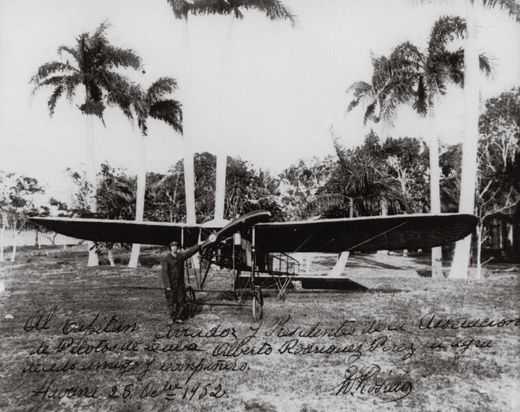Book Excerpt: “On Cuban Wings”
Chronicling the island’s rich aviation history
/https://tf-cmsv2-smithsonianmag-media.s3.amazonaws.com/filer/rosillo-388-aug07.jpg)
The rise and fall of Cuban aviation, as explored in Diana Rodriguez explore the roots of Cuban aviation, and its close link with the United States, in the following preamble to their book On Cuban Wings (Eagle Lithographers, Inc., 2002).
For more than 500 years after Christopher Columbus discovered Cuba and named it la tierra mas hermosa que ojos humanos han visto (the most beautiful land that human eyes have ever seen), the fate of Cuba and the United States have been closely tied. This is true with aviation as well.
In 1829, when the first balloonists arrived in our country, Cubans looked in awe at these heroic pioneers who risked their lives, and they began imitating them. Among Cuba’s aviation pioneers were Agustin Parla, Domingo Rosillo, Jaime Gonzalez Crocier, and Antonio Menendez Pelaez. While it is true that they were not the first [to fly], it is also true that Cubans since an early time took as their own the task of rising into the air to perform all sorts of aerial acrobatics.
More remarkable is the extraordinary evolution that the Cuban pilots went through, adapting to new technology almost immediately. The world’s commercial aviation industry today is not only about the millions of passengers flying around the planet. Its importance is also demonstrated in the movement of tons of merchandise and cargo. In Cuba, especially during the early years of flight, the aviation industry was of great benefit to postal services, speeding up communications around the island.
By the end of 1958, Cuba could easily handle its own national consumption with different established industries. Factories there produced such goods as candy, chocolate, and crackers; automobile tires and batteries; textiles such as rayon and nylon; paper, cement, and concrete; iron, aluminum, and steel; cosmetics, perfumes, and soap; sausage, milk and cheese – the list goes on! These growing industries served not only the nation’s consumer needs but also Cuba started exporting to other countries.
Because of its privileged geographical position between North and South America and its shipping routes, Cuba was considered a perfect place for the commercial use of the new air transportation industry. Havana was only 90 miles from the United States and also very near to Central and South America. Air and sea shipping contributed enormously to the increase in the exporting of merchandise and raw materials. Cubans were always hardworking and ambitious, as shown by their heroic aerial feats over the years. Cuban ingenuity contributed to the top position that Cuba held in military and commercial aviation, with first-class flying schools for future pilots as well as first-rate labor laws for the protection of the working class.
In 1957, [the national airline] Cubana de Aviacion ordered two 707-121 jet airplanes from Boeing, at the price of $200,000 each, with the option to buy a third jet. This would have made Cubana the first airline in Latin America and the fourth in the world, after Pan American, United and American airlines, to begin flying jets on their routes. But Fidel Castro’s “revolution” ended all these plans and dreams.
With the beginning of the “revolution” [in January 1959], the growing air industry in Cuba was finished, along with all private enterprises. Many of the military pilots were unjustly incarcerated or banished from Cuba. All private airplanes were confiscated by the new government, and most of the pilots and employees of Cuban and other airlines went into exile. Due to their expert training, they were immediately hired by the U.S. and other foreign airlines. Many other military and commercial pilots enlisted in the U.S. Air Force and they intervened in the fatal Bay of Pigs invasion. We trust that future generations of Cubans might be able to testify about the wonderful heritage received from these “Knights of the Air.”
To learn more about the history of Cuban aviation, see:
Cuba’s Commercial Aviation History and the Pichs Collection
Cuba Aereo: Aviation Memorabilia from the 40s and 50s
